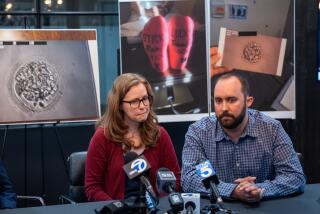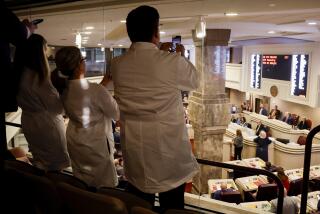It’s a Boy--Embryo Is Viable After 1990 Freezing
- Share via
Billy was conceived in 1990 in Los Angeles.
He was born Monday in Tarzana.
The reason for the delay was part modern medical science and part bookkeeping mistake.
The embryo from which Billy grew languished forgotten in a freezer for 7 1/2 years, the longest known time for an embryo that was later revived and implanted in a woman’s womb.
The embryo was left over from 1990, when Billy’s parents underwent a laboratory process used for couples who cannot conceive naturally, extracting eggs from the prospective mother for fertilization. The process resulted in a successful pregnancy, but there were leftover fertilized embryos.
And until 1997, neither they nor their doctor knew that those embryos had been placed in deep-freeze storage.
Eight months ago, these embryos were thawed and implanted. One of them survived and the result was baby Billy--a healthy 8-pound, 15-ounce boy delivered by caesarean section Monday at Tarzana Regional Medical Center with an unusual tie to his older brother.
“They are actually twins,” said Dr. Michael Vermesh, an infertility specialist who oversaw the gestation of both children. “They were conceived from different eggs, but on the same exact day.
“So, they are fraternal twins, born almost eight years apart.”
The story began in 1989, when the couple visited Vermesh, then on the faculty at USC. (The parents wished to remain anonymous and declined to be interviewed; Billy is not the newborn’s real name.)
“She could not conceive naturally,” said Vermesh, whose private practice is now located on the grounds of the Tarzana hospital.
The couple decided on a procedure called Gamete Intrafallopian Transfer, or GIFT.
The woman received hormone injections to stimulate the production of several more eggs in a month than the one produced during a normal cycle. The eggs were retrieved through a surgical procedure and then mixed in a laboratory catheter with her husband’s sperm. The mixture of eggs and sperm was then transferred directly into her fallopian tubes so that fertilization could occur.
All went well. She became pregnant and the couple’s first child was born in 1990.
Normally during this procedure, leftover viable eggs are fertilized in a laboratory dish--in vitro--and resulting embryos are frozen.
“It’s so that if the woman does not become pregnant, we can try again, a couple of months later,” Vermesh said, “without going through the whole process of stimulating egg production and retrieving the eggs.”
The frozen embryos are also commonly used two or three years after a successful pregnancy if the couple want another child. Vermesh said the longest previous time that an embryo had been frozen before being used was five years.
Sometimes, however, no viable eggs are left over. Because this particular couple never heard from the lab, that is what they and Vermesh assumed--incorrectly--had happened.
Normally, the parents’ assumption would have been corrected when they continued to receive a bill for storage fees, Vermesh said. “But they never got a bill.”
The couple were interested in having a second child, but--assuming they would have to start over--did not have the $7,000 that the full GIFT processes cost. By contrast, using already-frozen embryos in a pregnancy attempt costs about $1,000.
Eventually, the woman passed the age of 40, when the success rate of these processes takes a downturn. “She gave up on the idea of ever conceiving again,” Vermesh said.
Then in 1997, she got a letter from the laboratory.
“It informed her that her three frozen embryos were being relocated to a new facility,” Vermesh said. “It was the first she knew of them.”
The couple decided to try again, even though she was now 44. “That didn’t really matter,” said Vermesh. “The embryos were those of a 36-year-old woman.”
Although the embryos might be the oldest ever implanted, this does not mark a medical breakthrough, according to Dr. Alan DeCherney, chief of obstetrics and gynecology at UCLA.
“It’s no big deal,” said DeCherney, who edits the journal of the American Society for Reproductive Medicine. He noted that frozen human embryos had been used successfully to bring about pregnancies since 1984.
Once it had been established that they could be frozen for use later, the length of time in the freezer became of little importance, he said.
“The frozen embryos are probably good for 200 years,” he said. “It doesn’t seem to be big news that one could be kept for seven years and then used.”
DeCherney said he thought it was likely that some other physician has implanted an embryo at least that old, but did not think the event notable enough to publicize.
Indeed, the Pennsylvania Hospital in Philadelphia reacted to news of the Tarzana birth by announcing that a baby born there in December had grown from an embryo that had been frozen about four months longer than Billy’s.
*
But Vermesh said he believes keeping track of such matters and publicizing them is important.
“Now, if a woman comes to a doctor and asks if an embryo frozen that long can be used, the doctor can tell the patient it’s on record that she can get pregnant and the pregnancy can make it,” he said.
But there is a more important lesson to be learned from this couple’s story, he said.
“I’m sure that there are couples out there who have frozen embryos they don’t know about,” Vermesh said. “Because of a lack of communication or miscommunication, they don’t know that after in vitro fertilization, they had embryos put in storage.”
Did the laboratory that froze the Billy embryo ever try to collect seven years of storage fees?
“Thank God,” Vermesh said with a laugh, “they did not.”







